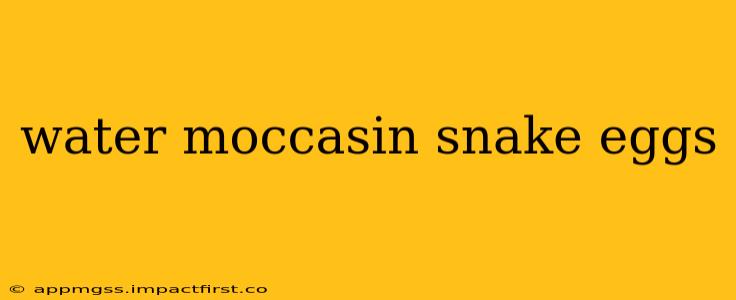Water moccasins, also known as cottonmouths ( Agkistrodon piscivorus), are venomous snakes that inhabit wetlands and waterways across the southeastern United States. Understanding their reproductive habits, including their eggs, is crucial for appreciating their role in the ecosystem and ensuring responsible interaction with these fascinating creatures.
What do water moccasin eggs look like?
Water moccasin eggs are typically white or cream-colored, leathery, and somewhat elongated. They are not as perfectly round as some other snake eggs and tend to be slightly oval in shape. The size varies somewhat depending on the mother's size and overall health, but they generally range from about 1 to 1.5 inches in length. The leathery shell helps protect the developing embryos from damage and desiccation. They're not as fragile as bird eggs, for example.
Where do water moccasins lay their eggs?
Unlike some snakes that lay their eggs in open nests, water moccasins exhibit a unique reproductive strategy. They are primarily ovoviviparous, meaning they give birth to live young rather than laying eggs that hatch externally. The eggs hatch internally, and the mother gives birth to a litter of fully formed, venomous snakes. This adaptation helps protect the young from predation in their often harsh environments.
Do water moccasins lay eggs? The exceptions to the rule.
While the vast majority of cottonmouths give birth to live young, there have been rare instances reported of oviparity (egg-laying) in some populations. These instances are uncommon and are generally attributed to specific environmental factors or genetic variations. More research is needed to fully understand these exceptions.
How many eggs/young do water moccasins have?
The number of young a female cottonmouth produces varies but typically ranges from 1 to 18, with an average of about 8 to 10. The size of the litter can depend on various factors, including the mother's size, age, and overall health.
What are the eggs/young like after hatching/birth?
Newly born water moccasins are fully formed and venomous from birth. They are typically around 8-10 inches long and possess all the defensive mechanisms of adult snakes, including their characteristic venomous bite. They are immediately independent and must fend for themselves.
What eats water moccasin eggs/young?
Several predators target water moccasin eggs and young. Because the eggs rarely, if ever, get deposited externally, predation is more focused on the young snakes. Larger snakes, birds of prey (like herons and hawks), and other reptiles may prey upon the newly born snakes. Fish may consume very young snakes, depending on the habitat.
Are water moccasin eggs poisonous?
Water moccasin eggs themselves are not poisonous. However, the young snakes that hatch from them are venomous, and handling them presents a serious risk. It's essential to avoid contact with these snakes, regardless of their age.
Are water moccasin eggs dangerous to humans?
No, water moccasin eggs themselves pose no direct danger to humans. The risk arises from the venomous nature of the snakes that emerge from those eggs.
This comprehensive guide offers detailed information regarding the reproductive habits of water moccasins, dispelling some common misconceptions and emphasizing the importance of safe observation and respectful coexistence with these fascinating creatures. Remember to always admire these snakes from a safe distance and never attempt to handle them.
